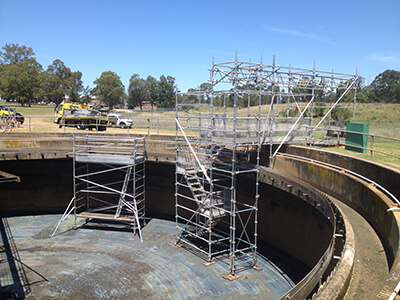I was watching a contractor replace a fence for me recently, and though it had been dry for a week or so, rain overnight had made the ground slippery around the steeper inclines where he attempted to work. Bracing himself with a paling from the old fence, he found stable footing and continued to work. Safe Scaffolding needs a little more planning than that, but the principals remain similar.
Mobile Scaffolds are a wonderfully versatile and manoeuvrable product. Providing quick and easy access to previously inaccessible areas. Like any structure though, temporary or permanent alike, there are always things to think about before you set-up and start.
Have a look around where you are going to place your scaffold. Start at the spot where you intend to undertake the assembly, and move to each spot where the scaffold will be used. Look at the ground that you will travel over for holes, obstacles or trip hazards. Look up. check clearance for trees, fixtures and most importantly any power or lighting wires. Check each area for access and stability.
A Mobile Scaffold should not be used on a slope greater than 5 degrees. Along the length of a 2.5 metre scaffold, that would mean any slope that required an adjustment of 21cm(half the available screw height) or more on the wheels at one end. If Greater than this, then you should be using jacks, not wheels, and even then, an experienced professional is recommended.
If your Scaffold is fitted with outriggers, then you should plan how and where they will be placed at each work area, ensuring they are in place and secured before the scaffold is used.
Remember to think of things like doorways, windows, walkways and other movable objects. If these have the ability to contact your scaffold, lock or secure them and keep the keys with you until the scaffold is moved. Returning to replace a broken window will take more time than tracking the keys down.
If the ground where your scaffold is to be used leaves a track of any kind, or allows the wheels to settle into it in any way, the wheels should be replaced with jacks, and the jacks should be placed on pad pieces to spread the weight. Remember, a worker on the scaffold will greatly increase the weight, and a single wheel sinking into a poorly prepared site will make your scaffold unstable.
A Mobile Scaffold should never be moved or adjusted whilst occupied. Access should always be via the internal ladder, and all components must be in place at all times whilst in use. (Do not allow painters to remove guardrails to allow full height rolling)
Always know the number of people or weight your scaffold is designed for. An EASYSCAF tower is rated for light duty work, meaning 225kg. This equates to two average sized workers plus tools. A SUPASCAF tower is rated for medium duty work, meaning 450kg. Aluminium Mobile Scaffolding is NOT intended for use as a stand for Brickwork or any heavy structural materials.
If you have any detailed questions, or need more advice, you can check our FAQ page, or give our team a call on 1300 677 223

